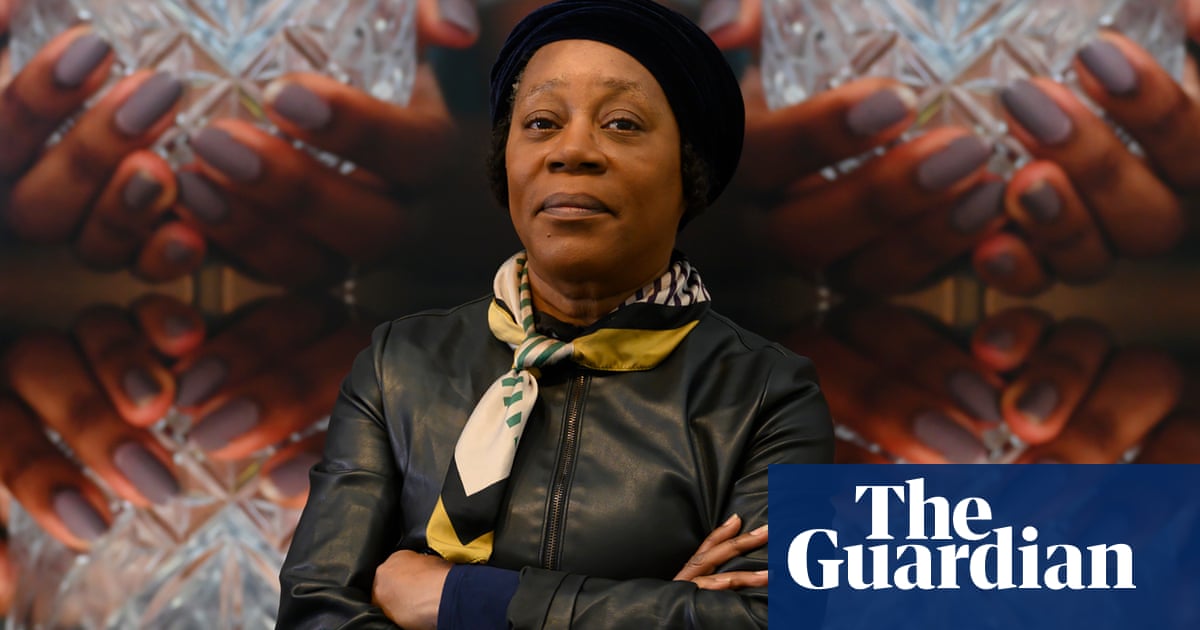
When Sonia Boyce was at primary school she won a book. “It was the first one that actually belonged to me, rather than just being in the house or from the school library,” she says. The book was Charlie and the Chocolate Factory, and she was particularly fascinated by Willy Wonka’s lickable, snozzberry-covered wallpaper, and the square sweets that looked round. It was a lightbulb moment, involving “this conundrum, a perceptual thing that I couldn’t figure out”.
As a young child she had found wallpaper terrifying, she explains. “It definitely fed into my nightmares. I’d wake up convinced that the wallpaper was moving and I actually do believe that there is something about it that is like entering a storybook or a fable, even though it’s this thing that’s meant to sit in the background, quietly, holding a space.” Her parental home in London was papered in the jazzy designs that were popular in the 60s and 70s; her current home has nothing except bookshelves on the walls – not even pictures, she says. She has loads but they’re all stacked up on the floor.
We’re in Margate’s Turner Contemporary where Boyce is restaging Feeling Her Way, her Golden Lion-winning entry to last year’s Venice Biennale. Its echoing white spaces are so far dominated by scaffolding and heavy lifting equipment, apart from one wall covered with blingy gold wallpaper, intricately patterned with geometric shapes.
Thickly swaddled against the biting sea wind, Boyce cuts a diminutive figure with a big sense of humour. Looking up at a large sculpture based on the crystalline structure of iron pyrite (fool’s gold) that is in the process of being suspended from the ceiling, she imagines herself as the wicked witch of the east, from The Wizard of Oz, with just her legs sticking out, she jokes. In terms of her work, there is no doubting her stature: she is not only the first black woman to represent Britain at Venice, but was the first to be collected by the Tate, and to be elected a Royal Academician.
What does this latest achievement mean to her? It has given her the luxury, for the first time in a 40-year career, of developing a long-term vision instead of fitting her art work around art college teaching, she replies. Because her practice is social, and involves assembling groups of people, this time limitation has forced it to become iterative – “working with one group and then going on to work with another. But now I’m actually thinking, OK, what are my five- and 10-year plans? I’ve just never been in that position before, so it has been a really significant shift.”
By the time the Margate show opens, the gold wall will be populated with mementoes – old album covers, posters, cassette cases – accumulated over a five-month period between 2021 and 2022, as part of her long-running “devotional project”. Some were donated, others she collected herself. “I’m always going in and out of charity shops, riffling through LPs and cassettes. I’ve got my regular shop in Brixton. They say, ‘Hi, she’s back.’”
She started the devotional collection in Toxteth in the late 1990s, as a tribute to all the black British female singers that nobody could even name in the home city of the Beatles. In Feeling Her Way, it dovetails with videos of four singers – Jacqui Dankworth, Poppy Ajudha, Sofia Jernberg and Tanita Tikaram – improvising separately and together in London and Sweden under the direction of composer Errollyn Wallen.
The installation, which is arranged over five rooms, carries DNA from the period of its composition, not only in obstacles overcome (Covid restrictions meant that Jernberg had to collaborate from Stockholm), but in the solutions it offers: it was important, says Boyce, to structure it so as to keep the audience flowing through the space in a socially distanced way. In Venice, speaking no Italian, she bonded with a technician who spoke no English but communicated through his love of the Spice Girls. “Every day he would sing a Spice Girls song to me. It was really sweet.”
A Tikaram superfan was one of the donors of the memorabilia that will be dotted around the gold wall. “Thank you – it’s in the catalogue,” says Boyce, directly to my voice recorder, as if addressing the donor. It’s a cheeky moment, but also one that reflects her respect for the role of memorabilia, as a shrine to “the musicians that people loved”. The devotional project as a whole, she says, “is about recognising that music occupies a subterranean realm within our lives. For some reason, we attach very significant moments to certain music. People will tell me really quite intimate things about the role that music played in their life.”
When she showed her installation, Devotional, at the National Portrait Gallery in 2007, one elderly couple confided their children were conceived to Joan Armatrading. “And I’m thinking, OK, maybe too much information, but also thinking: oh, that’s kind of lovely.”
Boyce was born in London to parents who had arrived separately from Barbados, as part of the Windrush generation. When they met, her father was working as a cinema projectionist and her mother was nursing, supplementing her earnings as a seamstress in the East End. They were ambitious for their children, investing their hard-earned money in a piano, and music lessons, which she managed to bunk off undetected until a neighbour spotted her hanging around a local park, much to her mother’s enduring fury. The family’s musical hopes were finally dashed by a humiliating recital by Boyce and her sister, on a Bontempi organ, in their local church.
Her drawing talent was more spontaneous and promising, and she graduated from school in London to Stourbridge College in the West Midlands, emerging to become part of a pioneering wave of black female artists that also included the Turner prize-winning Lubaina Himid. When, aged 25 in 1987, she sold a drawing to the Tate, her course as a star of British art seemed set. But then she moved into a hard-to-collect social practice, with the result that it was only after her selection for Venice was announced that she was picked up for the first time by a commercial gallery.
On the way to the interview, I’m warned that she is tired of being asked about what it means to be the first black British woman to win at Venice. It’s not that she is shy of making political statements: in 2018 she created a public furore by removing John William Waterhouse’s 1896 painting Hylas and the Nymphs from the wall of the Manchester Art Gallery in an attempt to draw attention to museum policy on what is made visible to the public.
When I finally do ask her, she quotes a phrase coined by the art historian Kobena Mercer in a 1990 article titled Black Art and the Burden of Representation. “The idea that one stands there as a representative [of a minority] is something that is projected on to me, and it has always been projected on to me, and to many others who are in a similar position, whether it’s a question of gender, or race or sexuality,” she says.
As to whether this is a breakthrough moment for women in general, after a year of high-profile successes, she lets out a big sigh. As a teacher (currently at University of the Arts London) she is only too aware of the disparity between the proportion of female art students and the numbers who manage to make a career of it. “At least from the beginning of the 20th century, 50% of the students at most art schools in this country were female, yet we’re still considered to be doing well if 30% of any shows have women in them.
“Things seem to come in cycles and waves. I wish they didn’t. I wish it was much more permanent. I don’t know why it takes so long to just recognise that women have skills, and are creative, and work, or why the question of value becomes such a battleground. If something affects you then it affects you; if something feels valuable, then value it.”
The pyrite-based structures in the show, which include stools for the audience to sit on as they watch the videos, and wall sconces holding the memorabilia, embody this hard-won wisdom in a characteristically life-affirming way. Fool’s gold is “an impostor, an imitation, not quite valued”; but it’s also a glitzy rock star: “Just a little joke I was having with myself,” she says.
Sonia Boyce: Feeling Her Way is at Turner Contemporary, Margate, from 4 February to 8 May, and at Leeds Art Gallery from 25 May to 5 November












